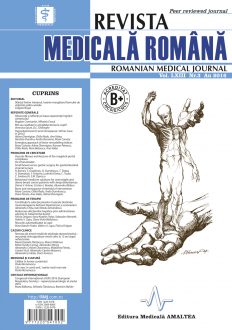SELECT ISSUE

Indexed

| |

|
|
|
| |
|
|
|

|
|
|
|
|
|
|
HIGHLIGHTS
National Awards “Science and Research”
NEW! RMJ has announced the annually National Award for "Science and Research" for the best scientific articles published throughout the year in the official journal.
Read the Recommendations for the Conduct, Reporting, Editing, and Publication of Scholarly work in Medical Journals.
The published medical research literature is a global public good. Medical journal editors have a social responsibility to promote global health by publishing, whenever possible, research that furthers health worldwide.
Bone and menopause: threshold of intervention
Adina Ghemigian, Ana Valea, Anda Dumitrascu, Dana Terzea, Mara Carsote and Otilia Radu
ABSTRACT
Menopause comes with different changes including estrogen deficiency – related qualitative and quantitative progressive skeleton deterioration. The physiological process turns to pathology, respective osteopenia and osteoporosis at central DXA (Dual-Energy X-Ray Absorptiometry) or low lumbar – DXA derived TBS (Trabecular Bone Score) or increased 10-year probability of major osteoporotic/hip fractures provided by FRAX. We aim to briefly introduce the methods of menopausal fracture risk assessment if back pain is presented from an endocrine point of view.
This is a vignette type of manuscript focusing on imagery tools. A 60-year old smoker woman with 10 years since menopause and prior corticotherapy accuses persistent back pain for a few weeks, with mild to medium intensity and responsive to small doses of pain medication. Profile plain X-Ray showed no vertebral fractures. FRAX estimated risk was low. Lumbar DXA (GE Lunar Prodigy) showed osteopenia (a T-score of -1.9 SD) while TBS showed a deterioration of lumbar micro-architecture based on a value of 1,199. Further recommendations of stop smoking, healthy diet, physical exercise, vitamin D and calcium supplementation are necessary. Retesting using DXA is not necessary sooner than 2 years or even longer. Related to back pain, rheumatologic and balneology support and intervention are required for spondylarthrosis.
For daily practice, the approach of bone health and estimation of future fragility fractures in menopause combines gold standard DXA to most modern instrument TBS together with easy accessible online algorithms as FRAX. These do not display individual medical decision and adequate use of guidelines.
Keywords: menopause, bone, fracture, DXA, TBS, FRAX
Full text | PDF
